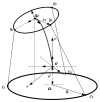Design and Optimization of a Hybrid-Driven Waist Rehabilitation Robot
- PMID:27983626
- PMCID: PMC5191101
- DOI: 10.3390/s16122121
Design and Optimization of a Hybrid-Driven Waist Rehabilitation Robot
Abstract
In this paper a waist rehabilitation robot driven by cables and pneumatic artificial muscles (PAMs) has been conceptualized and designed. In the process of mechanism design, the human body structure, the waist movement characteristics, and the actuators' driving characteristics are the main considerable factors to make the hybrid-driven waist rehabilitation robot (HWRR) cost-effective, safe, flexible, and well-adapted. A variety of sensors are chosen to measure the position and orientation of the recovery patient to ensure patient safety at the same time as the structure design. According to the structure specialty and function, the HWRR is divided into two independent parallel robots: the waist twist device and the lower limb traction device. Then these two devices are analyzed and evaluated, respectively. Considering the characters of the human body in the HWRR, the inverse kinematics and statics are studied when the waist and the lower limb are considered as a spring and link, respectively. Based on the inverse kinematics and statics, the effect of the contraction parameter of the PAM is considered in the optimization of the waist twist device, and the lower limb traction device is optimized using particle swarm optimization (PSO) to minimize the global conditioning number over the feasible workspace. As a result of the optimization, an optimal rehabilitation robot design is obtained and the condition number of the Jacobian matrix over the feasible workspace is also calculated.
Keywords: hybrid-driven; inverse kinematics and statics; optimization; waist rehabilitation robot.
Conflict of interest statement
The authors declare no conflict of interest.
Figures










Similar articles
- A Lower Limb Rehabilitation Assistance Training Robot System Driven by an Innovative Pneumatic Artificial Muscle System.Tsai TC, Chiang MH.Tsai TC, et al.Soft Robot. 2023 Feb;10(1):1-16. doi: 10.1089/soro.2020.0216. Epub 2022 Feb 21.Soft Robot. 2023.PMID:35196171
- SafeNet: a methodology for integrating general-purpose unsafe devices in safe-robot rehabilitation systems.Vicentini F, Pedrocchi N, Malosio M, Molinari Tosatti L.Vicentini F, et al.Comput Methods Programs Biomed. 2014 Sep;116(2):156-68. doi: 10.1016/j.cmpb.2014.03.001. Epub 2014 Apr 2.Comput Methods Programs Biomed. 2014.PMID:24750989
- Kinematics optimization and static analysis of a modular continuum robot used for minimally invasive surgery.Qi F, Ju F, Bai DM, Chen B.Qi F, et al.Proc Inst Mech Eng H. 2018 Feb;232(2):135-148. doi: 10.1177/0954411917747008. Epub 2017 Dec 11.Proc Inst Mech Eng H. 2018.PMID:29228866
- Review on design and control aspects of ankle rehabilitation robots.Jamwal PK, Hussain S, Xie SQ.Jamwal PK, et al.Disabil Rehabil Assist Technol. 2015 Mar;10(2):93-101. doi: 10.3109/17483107.2013.866986. Epub 2013 Dec 9.Disabil Rehabil Assist Technol. 2015.PMID:24320195Review.
- Towards Optimal Platform-Based Robot Design for Ankle Rehabilitation: The State of the Art and Future Prospects.Miao Q, Zhang M, Wang C, Li H.Miao Q, et al.J Healthc Eng. 2018 Mar 15;2018:1534247. doi: 10.1155/2018/1534247. eCollection 2018.J Healthc Eng. 2018.PMID:29736230Free PMC article.Review.
Cited by
- Virtual Sensors for Advanced Controllers in Rehabilitation Robotics.Mancisidor A, Zubizarreta A, Cabanes I, Portillo E, Jung JH.Mancisidor A, et al.Sensors (Basel). 2018 Mar 5;18(3):785. doi: 10.3390/s18030785.Sensors (Basel). 2018.PMID:29510596Free PMC article.
- Optimization of Perovskite Gas Sensor Performance: Characterization, Measurement and Experimental Design.Bertocci F, Fort A, Vignoli V, Mugnaini M, Berni R.Bertocci F, et al.Sensors (Basel). 2017 Jun 10;17(6):1352. doi: 10.3390/s17061352.Sensors (Basel). 2017.PMID:28604587Free PMC article.
- Safety Evaluation and Experimental Study of a New Bionic Muscle Cable-Driven Lower Limb Rehabilitation Robot.Wang YL, Wang KY, Wang KC, Mo ZJ.Wang YL, et al.Sensors (Basel). 2020 Dec 8;20(24):7020. doi: 10.3390/s20247020.Sensors (Basel). 2020.PMID:33302462Free PMC article.
- Design and Optimization of a Novel Three-Dimensional Force Sensor with Parallel Structure.Huang G, Zhang D, Guo S, Qu H.Huang G, et al.Sensors (Basel). 2018 Jul 25;18(8):2416. doi: 10.3390/s18082416.Sensors (Basel). 2018.PMID:30044432Free PMC article.
References
- Zanotto D., Rosati G., Minto S., Rossi A. Sophia-3: A Semiadaptive Cable-Driven Rehabilitation Device with a Tilting Working Plane. IEEE Trans. Robot. 2014;30:974–979. doi: 10.1109/TRO.2014.2301532. - DOI
- Zi B., Duan B.Y., Du J., Bao H.Y. Dynamic Modeling and Active Control of a Cable-Suspended Parallel Robot. Mechatronics. 2008;18:1–12. doi: 10.1016/j.mechatronics.2007.09.004. - DOI
- Zi B., Lin J., Qian S. Localization, Obstacle Avoidance Planning and Control of a Cooperative Cable Parallel Robot for Multiple Mobile Cranes. Robot. CIM-Int. Manuf. 2015;34:105–123. doi: 10.1016/j.rcim.2014.11.005. - DOI
- Qian S., Zi B., Ding H. Dynamics and Trajectory Tracking Control of Cooperative Multiple Mobile Cranes. Nonlinear Dyn. 2016;83:89–108. doi: 10.1007/s11071-015-2313-9. - DOI
- Surdilovic D., Bernhardt R. STRING-MAN: A New Wire Robot for Gait Rehabilitation. IEEE Int. Conf. Robot. 2004;2:2031–2036.
MeSH terms
LinkOut - more resources
Full Text Sources
Other Literature Sources
Medical
Research Materials
Miscellaneous
